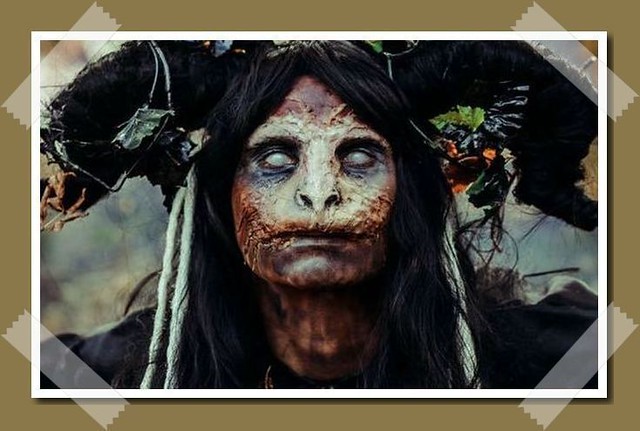Ragana

Ragana
ALSO KNOWN AS:
Rage (Pronounced: Rah-gay)
ORIGIN:
Baltic (Latvia and Lithuania)
Ragana’s name derives from a root word meaning “horn” or “crescent.” Alternatively her name derives from a root verb meaning “to see.” Ragana is an ancient, pre-Indo-European spirit, a powerful prophetess who reveals the future. She’s familiar with the past, too: devotion to Ragana dates back to the Neolithic era, the New Stone Age.
Ragana rules overnight, winter, birth, death, destruction, rebirth, and regeneration. She is a goddess of fertility, abundance, and menopause, which begins with the touch of her red wand. Ragana the prophetess sees all, knows all, and is all powerful. She is a goddess of death and a master healer who can allegedly cure any illness or ailment.
Ragana can bless or curse. She controls fertility and the milk supply of women and animals. She causes and cures infertility and impotence. Ragana controls the weather, raising and allaying storms, and wind. She is the guardian of nature’s cycles: creation, growth, decline, and destruction. Ragana may be understood as a spirit of balance. Even her negative powers may be understood as a blessing. Ragana halts the sun’s ascent after the Summer Solstice. What would happen if the sun’s power was left unchecked? If after the Summer Solstice, the sun’s power only increased?
• There may be one goddess Ragana.
• There may be a family of closely related spirits all called Ragana.
• There may be one goddess Ragana plus her entourage of handmaidens, lesser but still formidable spirits who are called Raganas.
• Ragana’s mortal priestesses and devotees are also known as Ragana.
In modern Latvia and Lithuania, the word ragana literally means “witch” (and not in the most positive sense of that word!). According to Lithuanian folklore, witches fly off to hilltops to rendezvous with Ragana on her holy night, the Winter Solstice.
Ragana cuts ice holes in frozen lakes to bathe in icy water. Ragana rarely walks. She flies by transforming into a bird or riding a stick, branch, or tree stump. Ragana is a seer. She doesn’t necessarily wish to be seen. Woe to men who surprise her and her handmaidens, especially if caught bathing, dancing, cavorting, celebrating, or otherwise in ritual. First Ragana and Raganas devour men sexually; then they literally devour them. (This myth of Ragana raises questions regarding the true identity of the hounds who consumed Actaeon after he interrupted Artemis and her Nymphs bathing.)
Ragana was Demonized long before the arrival of Christianity in the region. Venerated prior to the arrival of Indo-Europeans, she was never assimilated or incorporated into their pantheon in which male deities like Perkunas play dominant roles. Pre-Indo-European goddesses were assimilated by marriage to these deities. Ragana, apparently not ideal wife material, was not married to any of them. Author Vilija Vyté in the book Of Gods and Holidays: The Baltic Heritage describes Ragana as the “patriarchy’s nightmare.”
Following the arrival of Christianity, her image only got worse: Ragana was demoted to a witch who allegedly brings misfortune to humans and animals, a warning perhaps intended to make devotees stop venerating her. Fairy tales often portray Ragana as grotesque. Stories simultaneously celebrate and warn against her. Like her Russian soul sister, Baba Yaga, Ragana may be portrayed as a cannibal, yet her spiritual appeal and hold remain powerful. Ragana is invoked in positive and malevolent magic. Spells and incantations attempt to focus (or redirect!) her legendary destructive powers against the spell caster’s enemies. She is an increasingly popular Neo-Pagan goddess.
FAVOURED PEOPLE:
Witches, menopausal women
MANIFESTATION:
Ragana may manifest as a beautiful woman, bird, fish, hedgehog, poison toad or snake, sow, female dog, goat, or some nightmare creature.
ATTRIBUTES:
Broadsword, chalice, comb, red magic wand
ANIMALS:
Goat, hedgehog, mare, venomous snakes and toads
BIRDS:
Crow, magpie, owl
Fish:
Carp, pike
COLOURS:
Red, white
PLANET:
Crescent moon (horned moon)
Number:
3
Tree:
Birch
Plants:
Ragana’s power manifests in plants that heal, poison, or kill.
Time:
Winter Solstice and Summer Solstice— at the peak of Saulé’s power, Ragana begins the waning of the year: it is Ragana’s moment of glory, too.
OFFERINGS:
Ragana is traditionally given the first eggs of spring, a hunter’s first catch in spring, butter, cheese, hair, sheep’s wool, and menstrual blood.
SEE ALSO:
SOURCE:
Encyclopedia of Spirits: The Ultimate Guide to the Magic of Fairies, Genies, Demons, Ghosts, Gods & Goddesses– Written by Judika Illes Copyright © 2009 by Judika Illes.










